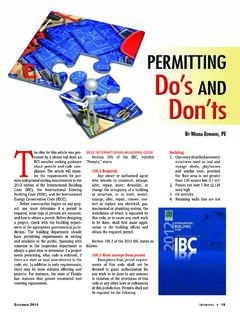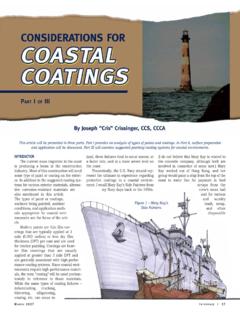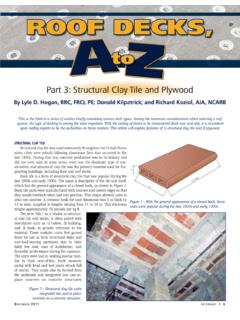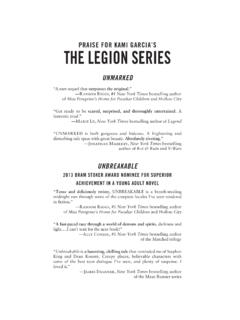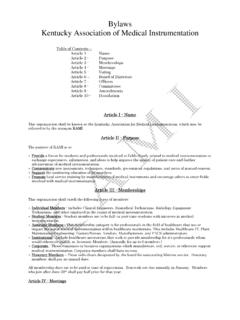Transcription of BY Kami Farahmandpour, PE, RRC, CCS, CCCA - RCI, Inc.
1 Figure 1 Typical high-rise building facade with exposed concrete structural elements such as slab edges, columns, and balconies (painted white). by kami farahmandpour , PE, RRC, CCS, CCCA 1. INTRODUCTION Building facades constructed of exposed concrete framing elements and infill windows are common for many high-rise residential, hotel, and insti tutional buildings (Figure 1). This results in economical construction and allows for free expression of the building structure. When properly designed and constructed, exposed concrete facade ele ments can provide a long service life with a reasonable level of mainte nance. Design, construction, and material deficiencies, however, can cause premature deterioration of the facade elements, necessitating costly repairs. The most common facade deterioration mechanisms are associated with cracking due to restrained volume changes in the concrete, corrosion of embedded reinforcing steel or balcony railing posts, and premature peeling of protective or decorative coatings.
2 These factors can contribute to water leakage, air infiltration, poor appearance, and safety concerns from falling concrete. If not repaired, severe concrete deterioration can also jeopardize the structural integrity of the building. This article provides a review of concrete repair methods and materials for building envelope applications. 2. REPAIR CONSIDERATIONS Prior to designing repairs to a concrete building facade, several factors should be considered. These include the following: Figure 2 - Cracking associated with extensive corrosion of the vertical reinforcing bars in a concrete column (approximately 20 stories high). 10 Interface March 2003 Cause and Extent of Deterioration A proper investigation of the deterioration mechanism and its extent should be made. Although under most circumstances the repair methods for spalled and delaminated concrete will be the same regardless of the cause, the deterioration mechanism and its extent may dictate a different repair approach in some cases.
3 For example, if high levels of chloride ions are present in the con crete, a more aggressive repair approach, such as the use of corro sion inhibiting materials or cathodic protection measures may be needed. Also, in most cases, the extent of the deterioration will have a significant impact on the decision to repair or replace a component ( , a balcony slab). The most common type of deterioration encountered in exposed concrete facades is that associated with corrosion of embedded metals (Figures 2 and 3). The second most common cause of deterioration in cold climates is the freeze-thaw damage to concrete elements. Coating failures and leakage through con crete cracks are also common problems (Figure 4). Figure 3 - Concrete spalling at an exposed slab edge due to corrosion of reinforcing steel. Repair Objectives Once the cause and extent of deterioration are determined, repair objectives should be defined.
4 Typically, one or more of the following will be the objective of the repairs: Improving the aesthetics of the building: In some cases, the concrete deterioration may not impact the structural integrity, watertightness, or the durability of the facade. If so, the only objective would be to improve the aesthetics of the building. Restoring durability of building components: In most cases, the main objective of the facade repair program will be to restore the durability of the concrete elements and to significantly reduce the rate of deterioration. It should be noted that, in most cases where corrosion of embedded metals is the cause of deterioration, completely preventing future deterioration is not practical. March 2003 Interface 11 Lifting repair materials and Figure 4 - Coating failure on a concrete shear wall on a high-rise facade.
5 Restoring structural integrity: If the extent of deteriora tion is such that the structure of the building has been compromised, the main objective of the repair program will be to restore the structural integrity of the affected components or the framing system. It should be noted that most conventional concrete patch repairs are cosmet ic in nature and will not produce composite action with the structural members. If a structural repair of the con crete is needed, special provisions for shoring and tempo rary removal of all loads from the members should be considered. Leakage control: In some cases, deterioration of concrete will result in unacceptable water intrusion through the building envelope components. In such cases, repair objectives will include controlling water leakage. Once again, due to the nature of the building envelopes with exposed concrete framing members, complete prevention of water intrusion is not practical.
6 Environmental and Logistical Limitations Repair design for exposed concrete (especially for high-rise buildings) should consider the unique environmental and logisti cal challenges associated with such work. The following are the most typical environmental and logistical factors that can influ ence specifications for exposed concrete framing elements: Wind: High wind on tall buildings can accelerate the dry ing of concrete patch materials and pose curing problems. Time limitation: On tall buildings, lifting of concrete patch materials to the repair location with a swingstage scaffold can take up to 30 minutes. This will shorten the pot life of many materials that have to be mixed on the ground. lowering debris: Deteriorated concrete that is removed will have to be lowered to the ground. Meanwhile, repair mate rials must be lifted to the repair location, all by scaffolding equipment that has weight and size limitations.
7 These factors can significantly limit repair options and methods. For exam ple, the use of shotcrete for repairs on tall buildings is usual ly not practical due to these fac tors. Worker fatigue: Working on high-rise facades from a swingstage scaffold while wear ing safety equipment is difficult at best. In some circumstances, workers have to remove con crete from soffits of balconies and slab overhangs while stand ing on a suspended scaffold. These conditions can cause worker fatigue and adversely impact the quality of work. In some cases, repairs that heavily rely on good workmanship are not possible on a consistent basis. Overhead protection: Performing repairs on a high-rise building facade will require overhead protection on the ground. Depending on the height and location of the building, the overhead protection may have to extend onto adjacent streets, etc.
8 Temporary weather protection: In most cases, removal and patching of concrete are not practical in the same day. Therefore, at areas adjacent to windows and other penetrations, concrete removal and surface preparation will render the building envelope more susceptible to water intrusion. Consideration should be given to tempo rary waterproofing. Inconvenience to building owners: Concrete repair tech niques involve the use of chipping hammers and sand blasting equipment. The use of chipping hammers will typically cause excessive noise and vibration to be trans mitted through the building frame. The vibration can result in damage to other building components, such as interior plaster and adjacent windows. Sandblasting can also create dust and can cause considerable damage on the ground if not contained properly. These factors should be considered during the design process and should be communicated to the building owners.
9 Temporary Support and Shoring It is common that the exposed concrete elements being repaired are structural framing members. Therefore, concrete removal around the reinforcing steel will reduce the structural capacity of the member. In high-rise buildings, significant removal of concrete from columns without due consideration to 12 Interface March 2003 the structural integrity of those columns can have catastrophic results. Also of importance are removing portions of balcony slabs and removing concrete from slab overhangs adjacent to columns where significant shear transfer occurs (Figure 5). Therefore, it is important that the anticipated location and extent of concrete removal be reviewed by a qualified structural engineer prior to specifying repairs. Of course, concrete removal should also be carefully monitored during repairs to avoid the same issues.
10 Cost Versus Service Life Like most things in life, longer lasting repairs can cost more. Features that enhance concrete repairs, such as protective coat ings, sealers, corrosion-inhibitors, and cathodic protection can add significant cost to repairs. However, due to the high access costs for building facades, the additional service life realized will typically offset the initial cost. Selection of Repair Materials Proper selection of repair mate rials is a critical step toward the successful repair of concrete. Experience has shown that materi als that are not compatible with concrete can fail prematurely, even if the repair material characteristics are superior. One of the most important materials used in the repair of con crete is the patch material itself. Experiences with epoxy and other resin-based materials have not yielded favorable results.
